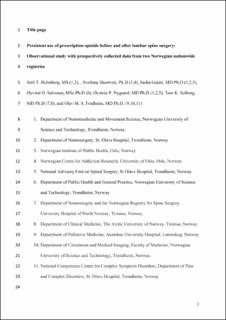| dc.contributor.author | Holmberg, Siril T. | |
| dc.contributor.author | Skurtveit, Svetlana | |
| dc.contributor.author | Gulati, Sasha | |
| dc.contributor.author | Salvesen, Øyvind | |
| dc.contributor.author | Nygaard, Øystein P. | |
| dc.contributor.author | Solberg, Tore K. | |
| dc.contributor.author | Fredheim, Olav M. S. | |
| dc.date.accessioned | 2024-04-11T12:54:46Z | |
| dc.date.available | 2024-04-11T12:54:46Z | |
| dc.date.created | 2023-05-15T13:44:21Z | |
| dc.date.issued | 2023 | |
| dc.identifier.citation | Spine. 2023, 48 (14), 969-977. | en_US |
| dc.identifier.issn | 0362-2436 | |
| dc.identifier.uri | https://hdl.handle.net/11250/3126143 | |
| dc.description.abstract | Study design. Prospective pharmacoepidemiologic study Objective. To investigate clinical and sociodemographic factors associated with persistent opioid use in the years following spine surgery among patients with persistent opioid use preceding lumbar spine surgery. Summary of background data. It is unknown whether successful spine surgery leads to a cessation of preoperative persistent opioid use. Methods. Data from the Norwegian Registry for Spine Surgery and the Norwegian Prescription Database were linked for patients operated for degenerative lumbar spine disorders between 2007 and 2017. The primary outcome measure was persistent opioid use in the second year after surgery. Functional disability was measured with the Oswestry Disability Index (ODI). Factors associated with persistent opioid use in the year before, and two years following, surgery were identified using multivariable logistic regression analysis. The variables included in the analysis were selected based on their demonstrated role in prior studies. Results. The prevalence of persistent opioid use was 8.7% in the year before surgery. Approximately two-thirds of patients also met the criteria for persistent opioid use the second year after surgery. Among patients who did not meet the criteria for persistent opioid use the year before surgery, 991 (3.3%) patients developed persistent opioid use in the second year following surgery. The strongest association was exhibited by high doses of benzodiazepines in the year preceding surgery (OR 1.7, 95% CI 1.26 to 2.19, P | en_US |
| dc.description.abstract | Persistent Use of Prescription Opioids Before and After Lumbar Spine Surgery: Observational Study With Prospectively Collected Data From Two Norwegian National Registries | en_US |
| dc.language.iso | eng | en_US |
| dc.publisher | Lippincott, Williams & Wilkins | en_US |
| dc.rights | Navngivelse 4.0 Internasjonal | * |
| dc.rights.uri | http://creativecommons.org/licenses/by/4.0/deed.no | * |
| dc.title | Persistent Use of Prescription Opioids Before and After Lumbar Spine Surgery: Observational Study With Prospectively Collected Data From Two Norwegian National Registries | en_US |
| dc.title.alternative | Persistent Use of Prescription Opioids Before and After Lumbar Spine Surgery: Observational Study With Prospectively Collected Data From Two Norwegian National Registries | en_US |
| dc.type | Peer reviewed | en_US |
| dc.type | Journal article | en_US |
| dc.description.version | acceptedVersion | en_US |
| dc.rights.holder | Copyright © 2023 Wolters Kluwer Health, Inc. | en_US |
| dc.source.pagenumber | 969-977 | en_US |
| dc.source.volume | 48 | en_US |
| dc.source.journal | Spine | en_US |
| dc.source.issue | 14 | en_US |
| dc.identifier.doi | 10.1097/BRS.0000000000004710 | |
| dc.identifier.cristin | 2147597 | |
| dc.relation.project | Norges forskningsråd: 320360 | en_US |
| cristin.ispublished | true | |
| cristin.fulltext | postprint | |
| cristin.qualitycode | 2 | |

